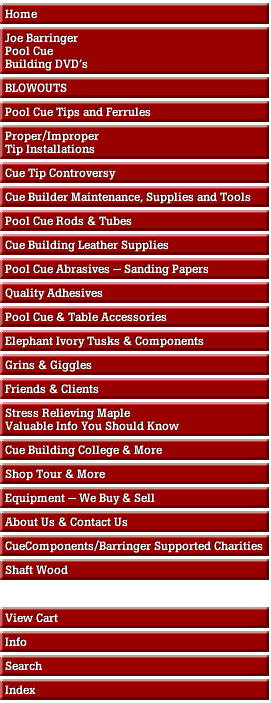

 This subject is so difficult to explain. Once again, we show Brian here sanding the epoxy finish. If you note, he is not wearing a mask. The reason for that is because of the downdraft table under the lathe. It makes all the dust go downward and into the collector. It really does work that efficiently. It's a great addition to any shop. Next, if you look closely, you'll see that Brian is using a real large piece of sand paper and using both hands. Now, why is he doing it that way? Well, because we taught him to do it that way. It's the right way. You want to sand smooth and evenly up and down the cue in large even motions. This method creates the results we desire. Those results are a cue that is level, smooth and even without hills and valleys. If you sand with one hand using a small piece of sand paper, you will, in all likelihood create hills and valleys. We actually sand using an 8.5" X 11" sheet of sand paper. We told Brian to use half that until he masters the technique. A full sheet is just too much sanding power for a beginner. We started him off with 3" X 5" sheets. He's already graduated to the next size of about 4" X 11". Do not build up heat and move in large even strokes up and down the cue - evenly. And remember, sand paper clogs up so be sure to check it as you are sanding and you can clean it out by using your air hose. Work clean, neatly and take your time. This method of sanding is paramount in achieving a smooth finish without hills and valleys. Just keep sanding and sand to the lowest imperfection, evenly throughout the cue. It's great advice. You'll thank us. Additionally, you can sand to smoothness using the above method. However, for final sanding you need to wet sand in up and down motions to remove all the hairlines. Do not rotate when final sanding. Use 400 grit up to 2000 grit in up and down motions to get all the hairlines out (which occur from rotating). You can then use Micro Mesh sanding sheets for a high gloss, smooth and hairline free job. Ok... I just remembered another story about Brain which I am certain you will enjoy. One evening, Brian came over around 9pm and said, "Dude, can I put a finish on that cue"? Of course, after putting in a full day, the last thing I wanted to do was baby sit and work on a cue. But as usual, I said go ahead. I walked into the shop with him and asked what he intended to do. He said, "I want to put a finish on the cue". Ok, he knew the procedure and waiting times in between. As such, I left and went back to my recliner. Brian came in and out and told me what was going on. I just smiled and said ok. After all, he thought he was a master since he has been working on cues for about a month. I left him alone. Now, please pay particular attention to the time he arrived which was 9pm. It was now midnight and I was wondering where Brian was and as such, I walked into the shop. Well, there was Brian sanding up a storm; he looked like the white knight! I did all I could not to bust a gut! He told me what had happened and I just smiled and rubbed it in -- Brian... I told you that you have to let the stuff dry. "I know Dude", he replied. I left the shop. It's now 3am and Brian was MIA so I was wondering what the heck he was doing. Actually, I knew what he was doing but i just had to see it. I walked into the shop and there was Brian with the saddest face, just putting the cue back up on the rack. He had enough. I saw that the cue looked like raw wood and asked him what had happened. Well, he said this and that but the bottom line was that he put one finish on but didn't let it dry enough before sanding and as such ruined it. He then had to sand all that work off and start over. Of course, he didn't learn by that mistake and did it all over again for a second time and so he spent 6 hours working and sanding for nothing. Well, I don't know if it was for nothing because we decided to put out a new model cue. It's called the pencil cue! Why? Because he originally started out with a cue that was around .820 at the joint. From adding finish and sanding back to wood, adding finish and sanding back to wood, he ended up with .775 at the joint. Hence, the pencil point cue. :-) So, what did Brian learn from all this? Well, we left him to do it his way (even though we told him the right way) because he just wouldn't listen and so mistakes are some peoples best lesson. Now, he comes over, puts the finish on, we talk a bit and he leaves. Yep, he let's it sit overnight and doesn't rush anymore. Some people have to learn the hard way. We let him make the mistake but he'll never forget it and now, he will always have patience. It was his best teacher. The end.... of this chapter. We're certain we'll have more stories, so stay tuned and don't miss the next thrill packed episode of....'The Amazing Adventures of Brian'. Now I feel like saying, same Bat channel. Now, we're giving away our age. :-) |